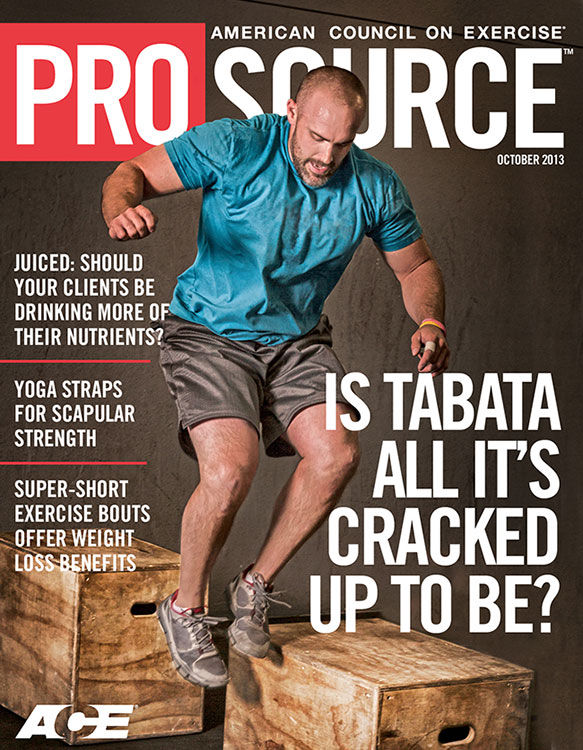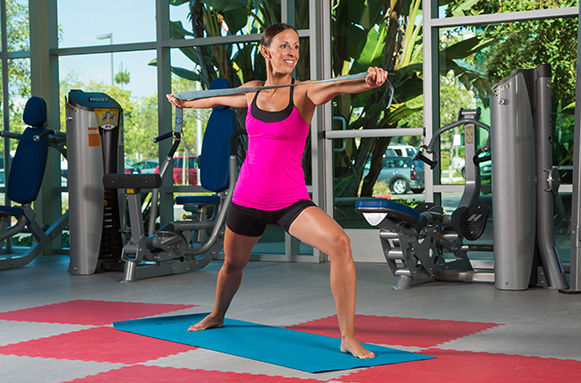
In a well-rounded yoga practice, it is important to demonstrate scapular—or shoulder blade—strength. For some people, however, achieving good form in yoga can be a challenge, particularly in poses emphasizing scapular stability, such as Warrior II and downward-facing dog. Incorporating yoga straps, however, can help your participants and clients learn how to properly engage the upper body during scapulothoracic movements.
Understanding the Scapulothoracic Region
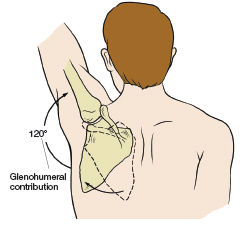
Relating to the kinetic chain, the scapulothoracic region is a stable joint located between two mobile regions: the thoracic spine and glenohumeral joint. Although the scapulothoracic region contributes to various degrees of movement of mobility, it is still considered a stable region. The scapulothoracic articulation is known as the joint of the scapula and the thorax, which lies underneath it. Depending on the movement of the arm, the scapula glides over the soft tissue of the posterior region of the thorax.
Figure 1: Scapulohumeral Rhythm
The glenohumeral joint and scapulothoracic articulation work together to produce upper-body movements, such as flexion and extension within the sagittal planes, and abduction and adduction within the frontal planes. This relationship and combined action is known as scapulohumeral rhythm. This rhythm features approximately a 2-degree arm movement for every 1-degree of scapular movement through the joint actions mentioned above. For example, if a student raises his hand to ask a question, the glenohumeral contributes to 120 degrees of movement, while the scapulothoracic contributes to 60 degrees of movement.
The scapular muscles are powerful stabilizers and are involved with many upper-extremity movements throughout a yoga practice. Various anatomical movements of the scapulae on the thorax include:
Elevation — Sliding of the scapulae upward in a vertical plane (toward the ears)
Depression — Sliding of the scapulae downward in a vertical plane (toward the hips)
Protraction (Abduction) — Movement of scapulae away from the spine toward the front of the body
Retraction (Adduction) — Movement of scapulae toward the spine
Upward Rotation — Movement where the scapula rotates in a vertical plane when the glenoid fossa faces upward and the inferior angle moves laterally toward the side
Downward Rotation — Movement where the scapula rotates in a vertical plane when the glenoid fossa faces downward and the inferior angles move medially toward the spine
Obtaining appropriate scapular strength not only enhances one’s yoga practice, but also provides appropriate stability for tasks off the mat such as picking up a bag of groceries.
It is common to see yoga participants who either lack strength or don’t understand the concepts related to the scapulothoracic region. Common deficiencies include:
- Scapular winging
- Shoulders shrugged toward the ears
- Roundness of the spine
- Arms not in alignment
Incorporating yoga straps brings awareness and concepts to life throughout a practice to better facilitate poses and positions. In fitness training, “Reactive Neuromuscular Training (RNT)” uses external stimulus to create an instinctive reaction. Incorporating yoga straps for scapular stability integrates RNT concepts to activate strength and stability. The straps bring a whole new dimension as to how the upper body should actually be engaged. Consider using the following poses that incorporate the strap so your participants and clients can learn and engage in the scapulothoracic movements.

Crescent Lunge “Flossing”
Purpose: Flossing is a movement that integrates upward and downward rotation, as well as abduction and adduction. This helps strengthen primarily the serratus anterior and increase range of motion. This concept provides the client with greater awareness of how the serratus should be engaged and how the shoulder blade glides along the thorax
How to perform: Align the lower body in Crescent Lunge and hold the strap overhead, with arms positioned slightly wider than, and in front of, the shoulders. Push outward on the strap to the point where the strap is tight and the upper-body muscles (including the triceps) activate, or “turn on.” Once engaged, slowly lower the strap in front of the body to where the elbows come near the side. Return back to center and continue for five to 10 breaths. Once this is complete, switch foot position and hold the strap statically overhead to get the sensation of scapular upward rotation and abduction. The motion is similar to a lat pull-down movement.
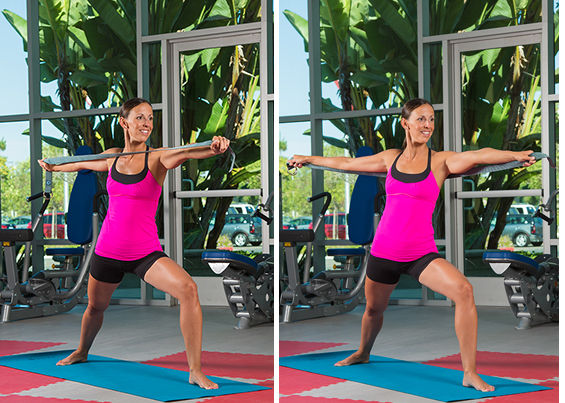
Warrior II
Purpose: The strap allows the shoulder blades to stabilize in depression and abduction, while the torso is upright and vertical. In Warrior II, it is common for the arms to not be in alignment, with one arm either higher or placed to the right or left of the torso. Thus, this means one shoulder blade with be elevated, retracted or over-protracted.
Transition From Crescent Lunge: Place the back foot at 45 degrees and bend the front knee toward a 90-degree angle. Bring the arms and strap in front of the body.
How to Perform: Hold the strap, and place arms in position. Apply outward force to where the biceps, deltoid and serratus anterior “turn on” and engage this region. The strap should be level across the chest and slightly touching the pectoral region. To progress, place the strap behind the back, with the straps just slightly touching the shoulder-blade region. If too much symmetrical or asymmetrical pressure is applied on the body, one or both shoulder blades are out of alignment.

Triangle Pose
Purpose: Similar to Warrior II, the strap allows the shoulder blades to stabilize in abduction with slight depression, but with the torso in lateral flexion. The top arm in this pose is often found “floating around” in many positions; therefore, the strap helps bring awareness to the alignment.
Transition From Warrior II: Straighten the front leg, keeping a soft bend at the knee.
How to Perform: Hold the strap and apply outward pressure. Laterally flex the spine until the bottom hand finds a resting position on the shin. Try to keep the arms and shoulder blades stable and initiate the movement from the spine. To regress, place the hand on the quadriceps; to progress, place the hand near the foot.

Chair Pose With Strap Rows
Purpose: The purpose of this pose is to recognize prime anatomical protraction and retraction movements while in an upright vertical position. This prepares muscle activation and recognition for positions such as chaturanga and downward-facing dog.
Transition From Triangle Pose: Release the legs and come toward the top of the mat with feet and legs touching.
How to Perform: Position the body in chair pose, and hold the strap in front of the chest with arms shoulder-width apart. Apply outward tension on the strap and begin to row the strap toward the chest, while retracting the shoulder blades; release to the starting point and protract the shoulder blades. Continue for five to 10 breaths.
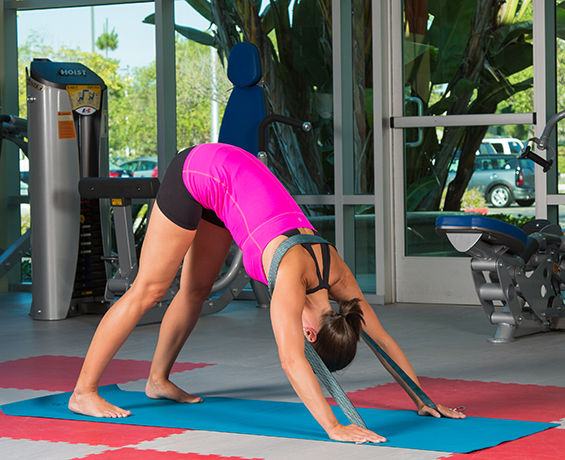
Downward-facing Dog
Purpose: In downward-facing dog, the arms “overhead” allow the scapula to move in elevation and upward rotation. However, while holding this pose, the shoulders need to externally rotate and slightly protract the shoulder blades. When the strap is snug, the shoulder blades are properly protracting and holding that resistance, while also “lifting” the rib cage (the ribs often collapse in the pose). The protraction activates the serratus anterior and “moves” the shoulders away from the ears.
Transition From Chair Pose: Place the strap behind the back and underneath the arms. Position the strap under the pads of the hand (under the four fingers) and lower into a forward fold and step the feet back into downward-facing dog.
How to Perform: If need be, lower onto the knees to readjust the strap. Externally rotate the shoulders and protract the shoulder blades into the strap. This should feel snug and stable around the sides of the rib cage. If the strap is loose, there is either excess strap or the shoulder blades are retracting instead of protracting.
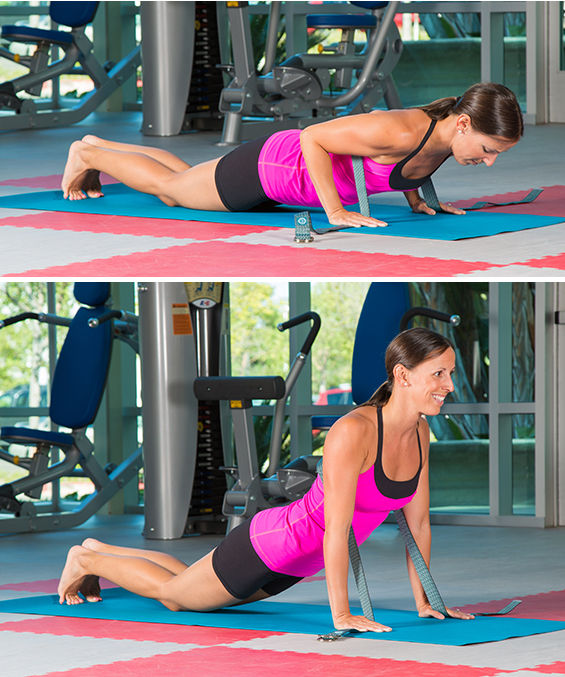
Reverse Chaturanga to High Push-up
Purpose: In chaturanga and high push-up, it is common to experience scapular winging. To develop the muscles and motion, the strap is used to develop the sensation on how to activate the serratus anterior and properly protract the shoulder blades.
Transition From Downward-facing Dog: Align the body into a plank position and slowly lower onto the knees and lie in a prone position.
How to Perform*: Place the strap around the back, directly toward the underarms. Align the body prone with the hands under shoulders and the strap under the pads of the four fingers. The strap should be snug, but not overly tight. Draw the navel toward the spine to activate the core and start to protract the shoulder blades as you simultaneously push against the strap to chaturanga (elbows at 90 degrees) and continue to protract the shoulder blades as you move to high push-up. The strap will glide and move under the hands as you push up. The goal is to focus on the protraction and resistance of the strap to feel the strength of the upper body and to avoid scapular winging and sinking of the thorax. Keep that same “feeling” and activation as you slowly lower toward the floor during the transition from high push-up to chaturanga.
* Note: This pose should be completed on the knees until the client has enough strength to sustain alignment through a full plank chaturanga.
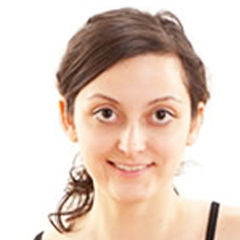




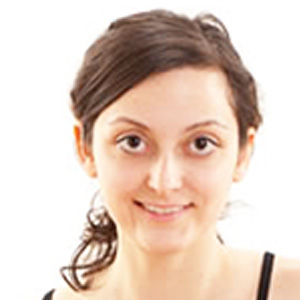 by
by 